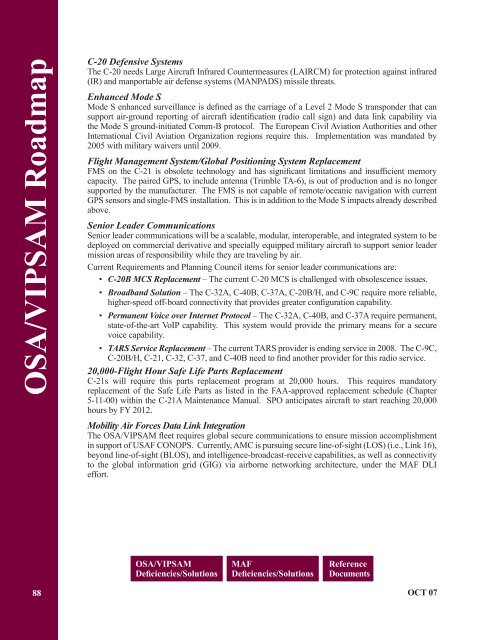Air Mobility Plan, 2008 - The Black Vault
Air Mobility Plan, 2008 - The Black Vault
Air Mobility Plan, 2008 - The Black Vault
You also want an ePaper? Increase the reach of your titles
YUMPU automatically turns print PDFs into web optimized ePapers that Google loves.
OSA/VIPSAM Roadmap<br />
C-20 Defensive Systems<br />
<strong>The</strong> C-20 needs Large <strong>Air</strong>craft Infrared Countermeasures (LAIRCM) for protection against infrared<br />
(IR) and manportable air defense systems (MANPADS) missile threats.<br />
Enhanced Mode S<br />
Mode S enhanced surveillance is defined as the carriage of a Level 2 Mode S transponder that can<br />
support air-ground reporting of aircraft identification (radio call sign) and data link capability via<br />
the Mode S ground-initiated Comm-B protocol. <strong>The</strong> European Civil Aviation Authorities and other<br />
International Civil Aviation Organization regions require this. Implementation was mandated by<br />
2005 with military waivers until 2009.<br />
Flight Management System/Global Positioning System Replacement<br />
FMS on the C-21 is obsolete technology and has significant limitations and insufficient memory<br />
capacity. <strong>The</strong> paired GPS, to include antenna (Trimble TA-6), is out of production and is no longer<br />
supported by the manufacturer. <strong>The</strong> FMS is not capable of remote/oceanic navigation with current<br />
GPS sensors and single-FMS installation. This is in addition to the Mode S impacts already described<br />
above.<br />
Senior Leader Communications<br />
Senior leader communications will be a scalable, modular, interoperable, and integrated system to be<br />
deployed on commercial derivative and specially equipped military aircraft to support senior leader<br />
mission areas of responsibility while they are traveling by air.<br />
Current Requirements and <strong>Plan</strong>ning Council items for senior leader communications are:<br />
• C-20B MCS Replacement – <strong>The</strong> current C-20 MCS is challenged with obsolescence issues.<br />
• Broadband Solution – <strong>The</strong> C-32A, C-40B, C-37A, C-20B/H, and C-9C require more reliable,<br />
higher-speed off-board connectivity that provides greater configuration capability.<br />
• Permanent Voice over Internet Protocol – <strong>The</strong> C-32A, C-40B, and C-37A require permanent,<br />
state-of-the-art VoIP capability. This system would provide the primary means for a secure<br />
voice capability.<br />
• TARS Service Replacement – <strong>The</strong> current TARS provider is ending service in <strong>2008</strong>. <strong>The</strong> C-9C,<br />
C-20B/H, C-21, C-32, C-37, and C-40B need to find another provider for this radio service.<br />
20,000-Flight Hour Safe Life Parts Replacement<br />
C-21s will require this parts replacement program at 20,000 hours. This requires mandatory<br />
replacement of the Safe Life Parts as listed in the FAA-approved replacement schedule (Chapter<br />
5-11-00) within the C-21A Maintenance Manual. SPO anticipates aircraft to start reaching 20,000<br />
hours by FY 2012.<br />
<strong>Mobility</strong> <strong>Air</strong> Forces Data Link Integration<br />
<strong>The</strong> OSA/VIPSAM fleet requires global secure communications to ensure mission accomplishment<br />
in support of USAF CONOPS. Currently, AMC is pursuing secure line-of-sight (LOS) (i.e., Link 16),<br />
beyond line-of-sight (BLOS), and intelligence-broadcast-receive capabilities, as well as connectivity<br />
to the global information grid (GIG) via airborne networking architecture, under the MAF DLI<br />
effort.<br />
OSA/VIPSAM<br />
Deficiencies/Solutions<br />
MAF<br />
Deficiencies/Solutions<br />
Reference<br />
Documents<br />
88<br />
OCT 07
















